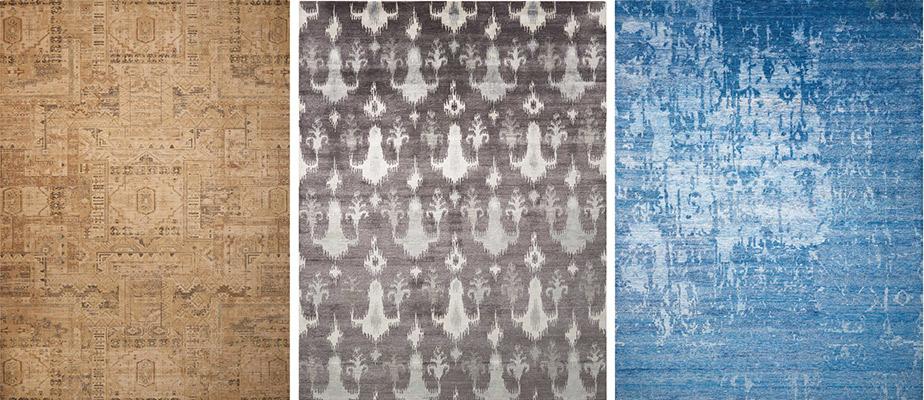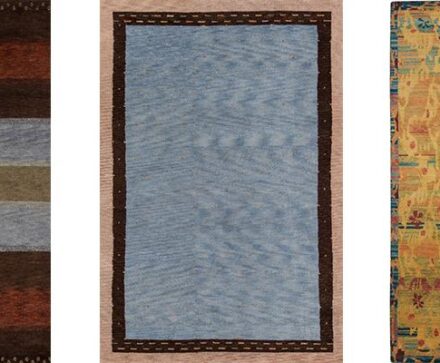Sari Silk Rugs

Sam Presnell of the Rug Gallery in Cincinnati discusses sari silk rugs and how you can display these beautiful masterpieces in your home for a look that is truly your own.
John Maher: Welcome to the Rug Gallery with Sam Presnell. The Rug Gallery is an Oriental rug company and carpet store in Cincinnati, Ohio. I’m John Maher, I’m here with the owner of the Rug Gallery, Sam Presnell. Hi Sam.
Sam Presnell: Hey John.
What are sari silk rugs?
John: So, Sam today we’re talking about sari silk rugs. Is it true that sari silk rugs are actually rugs woven from the silk of old saris?

Sam: No, but it sounds like it. Why not do that? you’re recycling right? Basically, the sari silks are what we call the entrails and the scraps from making saris. So, whenever you make something in a textile, you always have leftover carry over or excess stuff sticking out the sides of the loom, coming around the back to get scraped off. And so you have a lot of we call waste and so you take all those wastes, usually silks, very fine silks making those beautiful sari cloths. And then they’ll take all the waste products and they’ll sell that waste off. And somebody will take that waste and basically sort it by color, and then they’ll put it back together and spin it together as one fiber.
But you have a lot of different colorings coming through on any color. There is no really, what I call solid color sari. You’re going to see a lot of foreign and unusual colorings popping through and [it’s] usually very bright.
Sari Silk Rug Making Process
John: So tell me a little bit more about that rug making process for sari silk rugs and what’s unique about it.

Sam: So, basically you take the silk and you’re taking all these little small pieces of scrap of silk you’re trying to sort by color and then you’ll take it to a hand spinner or weaver, who will take those strands and start spinning them together so they apply together. So, you’re taking a product that is totally by-product that I guess what else would you do with it except throw it away or burn it or whatever, but basically this silk is so expensive it’s hard to believe you would waste something like that. So in this way, it gets rid of waste for them we will use it, we get a great price on it.
Usually, sari silks are very inexpensive compared if you wove it [from] a 100% mulberry silk from scratch and made it from scratch from silk. So, you’re taking a bunch of reds but not all the reds are the same, there’s like reds are darks reds, maybe a little green that got stuck in there with the red and when they spin it you’ll see that the colorings have different depths of different colors and that’s from the saris of all different saris being put together. They put everything together [in] one big pile and then spin it.
John: Okay, so can the leftover silk from making saris be mixed with other types of fibers to create the rugs or is it all just the silk?
Sam: It’s not mixed in [per se, but] I guess you can do about anything, but not what I’ve been noticing the rug business. I noticed that basically you’ll maybe weave part of the rug out of wool and then you weave parts of it with the sari silk or you weave it mostly with the sari silk and then a little bit of a different kind of wool or viscose or other silks as well with it. So, you may not see it always be a 100% [silk] but just part of it. Yes, they do blend with other yarns, but not so much in the yarn itself.
Sari Silk Rug Patterns
John: Does the rug when it comes out, the sari silk rug, does it look like it has a pattern to it or is it just the sort of blended colors that are mixed up?

Sam: It’s just like the rugs you would buy [like a] traditional Oriental rug, a transitional rug, a modern rug – it’s exactly the same design. It’s as clear as a bell, the designs and it isn’t like it’s not distinguishable. But I will say that there’s always exceptions in everything. Sometimes they’ll take the sari silks and they’ll over-dye them. They’ll actually put them in a bath of a solid color, green, blue, or whatever. And then when you take it out of the dye baths, you lay them out dry and then wash them. You’ll see that you’re seeing solid design, but it’s almost you don’t really see the other colors are there, you see the design popping through on that solid color.
That’s also very popular in the sari silks. It’s a product that was developed in India and is called the Aqua silk. And that was very popular for a long time and it’s still popular, it’s just not as popular as it once was — we called [it] over-dyed sari silk. And then the regular silk, the patterns are just distinctive as any rug you will see but you’re going to see so much irregularity in the design as far as the colors that are in that particular design.
Hand- Versus Machine-made Rugs
John: Okay. Are sari silk rugs generally handmade or machine made?
Sam: I’ve never seen a machine-made one. I think because of the irregularity of the yarn that it wouldn’t [be possible]. Machine sari thread pile wouldn’t go together real well, because it’s usually lots of little threads put together, it’s lumpy, it has different thicknesses and tightnesses to the spin. I think it would be very challenging to make [it with] a machine. I always hate to say no, but I would say as the big picture, no. When you see a sari machine made, but did you see it in all types of handwoven, it could be cloth, it could be a flat weave or Kilim type rug. I could be solid, it could be patterned. It can be done in about everything, it could be done in textiles as well.
Sari Silk Rug Texture
John Maher: When I think of silk, obviously I think of a very fine fabric, I guess we call it that silky texture with almost slippery in a way. Does the rug feel like that or what’s the texture of a sari silk rug?
Sam: It does not have the smoothness that you would find in your very fine silks. Yes, it does glisten, it does have a sheen, it does have that silk like appearance to it. It’s not as dramatically apparent in a sari silk because the mixtures are the different types of colors that come along with a sari silk. Yes, it is different than regular silk but it’s still very fine, it has a lot of characteristics of silk as well.
John: All right. That’s great information Sam. Thanks, again for speaking with me today.
Sam: Right John, thank you.
John: For more information about Sam, The Rug Gallery, and Oriental rugs and carpets visit [theruggallery.com] or call 513-793-9505. Make sure you catch the latest episodes by subscribing to this podcast on iTunes, and if you could take the time to give us a review on iTunes as well we’d appreciate that.
I’m John Maher, see you next time on The Rug Gallery.


